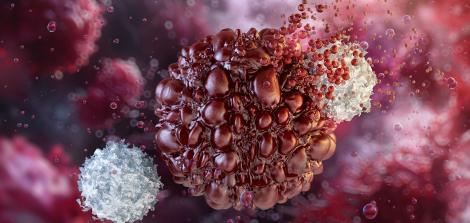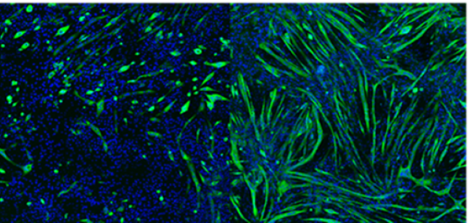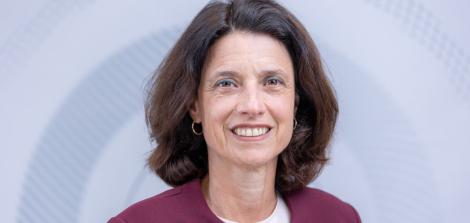Treating rare diseases: Dr. Einat Zalckvar cracks the peroxisome
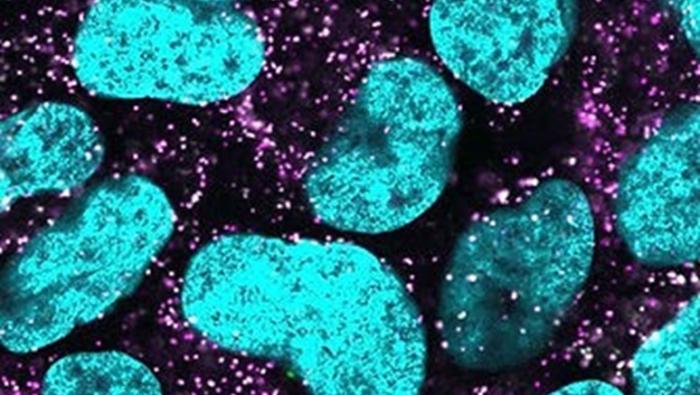
Rare genetic diseases pose an enormous challenge for researchers. These diseases are extremely uncommon, creating a significant obstacle in studying them and developing treatments. Not only is it difficult, and sometimes impossible, to conduct clinical trials with so few patients, but pharmaceutical companies lack the commercial interest for funding the research, for obvious reasons.
However, when considered collectively, rare diseases are not actually so rare. It is estimated that half a million people in Israel suffer from a rare genetic disease, accounting for 6-8% of the population – more than the number of patients with cancer, Parkinson's and Alzheimer's combined. Worldwide, the number of people with rare genetic diseases exceeds 300 million. But since these diseases include at least 7,000 different conditions – not counting additional diseases yet to be diagnosed – many of them are hardly researched at all.
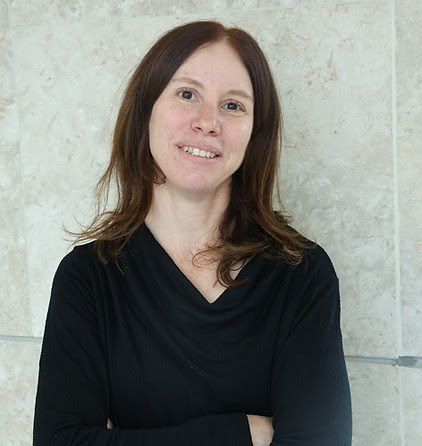
Dr. Einat Zalckvar. Credit: Dror Motola
The peroxisome: The star of "Lorenzo's Oil"
Rare genetic diseases span a very wide spectrum: some are extremely severe, with affected children dying within days or months, while others gradually impair abilities such as vision, hearing or movement.
One of the most famous is X-ALD, featured in the 1992 movie "Lorenzo's Oil," which is based on the true story of Lorenzo Odone. Lorenzo was born a normal child but began experiencing severe temper tantrums around the age of five, eventually leading to the diagnosis of a severe hereditary disease caused by a defect in the cellular lipid breakdown mechanism. Because it was a rare disease, pharmaceutical companies were not interested in funding research, and his parents sat in libraries themselves to search for a solution, eventually finding a way to delay the damage with a special oil.
The disease in the movie, X-ALD, is one of the genetic diseases caused by a defect in a cellular organelle called the peroxisome. In recent years, Dr. Einat Zalckvar from the Dangoor Center for Personalized Medicine and the Faculty of Life Sciences at Bar-Ilan University has taken an particular interest in the peroxisome.
Einat, can you explain exactly what a peroxisome is?
"Our cells are structured like a city. They are composed of units, each specializing in its own field, but they all must work together. The central unit is the nucleus, akin to a city hall, where the genetic material is located. Another organelle, called the mitochondrion, serves as the cell's energy center. The lysosome is the cell's waste recycling center, as the cell is a very ecological system, and its waste is used for other purposes. The peroxisome is a tiny organelle, about 150 nanometers in diameter (a nanometer is a billionth of a meter), where many activities occur, including the breakdown of toxic substances like free radicals. When the peroxisome is damaged, it causes disease."
How did you come to specifically research the peroxisome?
"For ten years, I researched yeast cells at the Weizmann Institute, not human cells, but a yeast cell is very similar to a human cell. As we know from working with dough, when you give yeast sugar and a pleasant temperature, it grows significantly. Moreover, it is easy to make genetic changes to yeast. It was Prof. Maya Schuldiner who suggested that I study peroxisomes. At that time, I didn't even know they existed, and it seemed strange to me that this organelle had been known for 60 years, yet we knew almost nothing about it."
That means there's still a lot to discover about it.
"Yes. We developed tools to study the peroxisome using yeast. We didn't know all the roles of the peroxisome and knew little about the proteins present in it, but we discovered 40 proteins whose existence there was unknown, and we studied the roles that some of them perform."
Personalized medicine: Using the patient's own cells
Dr. Zalckvar's lab at Bar-Ilan University opened in October 2023 with four researchers- and that number is expected to grow soon. "In the lab, there are both men and women, religious and secular – there is diversity, and that's very important to me. I believe that diversity contributes to creative thinking." They grow human cells in the lab, sourced from skin biopsies taken from the patient themselves, and they conduct experiments on the cells of the very patient for whom the drug is intended. "This isn't about a model or a similar animal; it's directly about the person for whom the drug is intended, allowing us to be much more precise."
What treatment is currently offered to patients with diseases caused by a peroxisome defect?
"For most diseases caused by a peroxisome defect, there is almost no treatment that has been scientifically tested. For some ALD patients, for example, bone marrow transplantation is offered. Sometimes, in cases of peroxisomal diseases, dietary changes are suggested because peroxisomes break down certain fatty acids, so switching to a low-fat or dairy-free diet can reduce the load on the peroxisome. Therefore, it's important to invest efforts in trying to help these patients."
How do you approach a project to develop drugs for such rare diseases?
"It's usually unrealistic to start development from scratch. Therefore, one of the main strategies is called 'Drug Repurposing' – we review a series of drugs already approved by the FDA for other diseases and examine how they affect the function of the specific patient's cells. We use unique systems of robots connected to microscopes, allowing us to screen many drugs in a short time."
You invest enormous efforts in treatments that will help a very small number of patients.
"People often ask me, 'Why work on rare diseases? Aren't there enough cancer cases?' But first and foremost, I believe that it is our moral duty to help every person. As it is written in the Mishnah: 'Whoever saves one life, it is as if they saved the entire world.' There is also another aspect: sometimes when we understand the mechanisms of cell defects in rare diseases, we make discoveries that allow us to treat much more common diseases. For example, very common cholesterol-lowering drugs that many people use today were originally developed to treat a rare disease that caused high levels of cholesterol to accumulate in the joints. Once the treatment for the rare disease was found, the knowledge could be used to develop a drug for the more common condition of high cholesterol."
So, understanding the peroxisome is relevant not only to rare diseases?
"Correct. Research on the peroxisome can shed light on much more common diseases like cancer and obesity – since the peroxisome is responsible for breaking down fats in the cell."
"Invisible Diseases"
In recent years, Dr. Einat Zalckvar has been fostering connections between doctors, researchers, the biotech industry and patient associations for rare genetic diseases. She is a member of the 8400 Rare Elite Group, a collective of top researchers, industry leaders and medical professionals in Israel who aim to advance the field of rare diseases. Recently, together with Prof. Maya Schuldiner and Prof. Ayelet Erez, and in collaboration with Bar-Ilan University and the Weizmann Institute of Science, she co-founded the Rare Genetic Diseases in Israel website. The website aims to provide accessible information about rare diseases.
"The need for the website arose because there is a lack of reliable and current information in Hebrew or Arabic about many of these diseases. At Bar-Ilan University, there is a group of researchers studying rare genetic diseases, and we organize meetings between researchers and doctors to improve the sharing of information on the subject. Interaction between all of the parties involved is crucial: the doctor is an expert on the clinical side, I am an expert on the scientific side, and the families know the case better than anyone – but none of us know everything, so we all have to work together."
Those who work alone will not succeed
One can say that Dr. Einat Zalckvar's career in genetics began at age 15, when a substitute science teacher taught her class about genetics. "What she taught us blew my mind. I was amazed. At the end of the lesson, I told myself – this is what I want to do when I grow up." After completing a bachelor's degree at Tel Aviv University, she earned her Ph.D. at the Weizmann Institute, and today her lab is part of the Dangoor Center for Personalized Medicine at Bar-Ilan University.
Why did you choose Bar-Ilan?
"Bar-Ilan University is very socially diverse; there are students here from all sectors of Israeli society, as well as international students. Diversity is a strength, because it brings together people with different perspectives. The atmosphere among the scientists here is also exceptional – there is a lot of collaboration and mutual support. I especially felt this as a new scientist, when colleagues really helped me with ideas and feedback."
What tip would you give to a researcher starting their career?
"I think students who pursue advanced degrees in life sciences are usually driven by curiosity and passion for discovering new things. Throughout most of their research journey, their experiments are not successful, because that's how science works. It is difficult for these students, who are usually top achievers, to suddenly face 'failures,' but it actually pushes them to think about why things didn't work, and to keep moving forward. A key trait of those who succeed in this field, despite the challenges, is their ability to collaborate. Anyone who tries to work alone simply won't succeed."
Main photo: peroxisome (purple) in human cells under microscope. Credit: Tamar Cohen.
Last Updated Date : 12/11/2024
